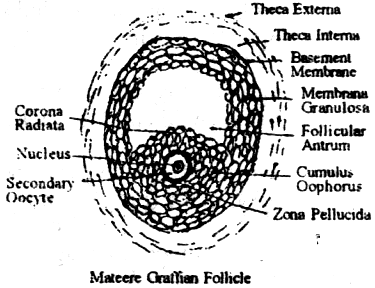
A follicle consists of an oocyte covered by homogenous membrane the zona pellucida. When the surrounding cells from a single layer they are called follicular cells. Later in development when they form several layers, they are referret to as granulosa cells. The surrounding cells nourish the depeloping oocyte and begin to secrete oestrogens as the follicle grows larger. The zona pellucida is surrounded by follicular cells called membrane granulosa. The follicle has ane centric follicular cavity of follicular antrum filled with a fluid, the follicular fluid or liquid folliculi. The oocyte adheres to the wall of the follicle through a.pedicel, the cumulus oophorus formed by granulosa cells and thus, remains suspended in the follicular cavity. Later, the granulosa cells lying is close vicinity of the oocyte and zona pellucida, become elongated to form the corona radiata. The membrana granulosa is surrounded by theca interna and theca externa. The total number of follicles is two ovaries of a normal young adult woman is about four lakhs. Many ovarian follicles (during primary oocyte stage) undergo degeneration. This degenerative process of folliciles is called follicular atresia and such follides are known as ateretic follicles.
The release of secondary oocyts from the overy is called ovulation. It occurs due to repturing of ovarian follicle and the wall of the ovary. Generally one secondary oocyte is released in each menstrual cycle (average duration 28 days) by alternate ovaries. Only about 450 secondary oocytes (ova) are produced by a human female over the entire span of her reproductive life which lasts about 40-50 years of age (in some cases 45-55 years.)